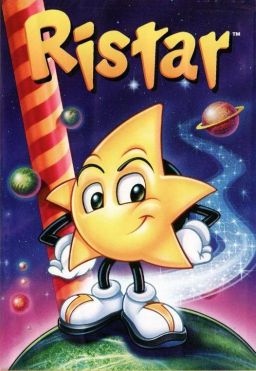
Ristar is a 1995 platform game developed and published by Sega for the Sega Genesis. The game stars an anthropomorphic cartoon star who uses his hands and long, stretchable arms to both move and fight enemies. Reception for the game was generally positive, but the game's initial release was overshadowed due to the imminent ending of the Genesis's lifecycle and the succession of the Sega Saturn and other fifth generation video game consoles.

Phantasy Star II is a science fantasy role-playing video game developed and published by Sega for the Sega Genesis. It was released in Japan in 1989, North America in 1990, and in Europe in 1990. It was later ported to a variety of different platforms. An updated remake, Phantasy Star Generation 2, was released for the PlayStation 2 in 2005 in Japan.

Gauntlet Legends is an arcade game released in 1998 by Atari Games and Midway Games. It is a fantasy themed hack and slash styled dungeon crawl game, a sequel to 1985's popular Gauntlet and 1986's Gauntlet II and marks the final game in the series to be produced by Atari Games. Its unusual features for an arcade game included passwords and characters that could be saved, enabling players to play over the course of a long period.
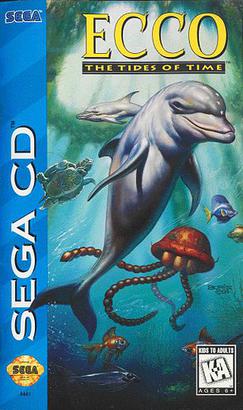
Ecco: The Tides of Time is an action-adventure video game developed by Novotrade International, published by Sega, and released for most of Sega's then-supported gaming consoles in 1994. It is the second game in the Ecco the Dolphin series. The Tides of Time continued the story of the first game and featured similar gameplay with a few new additions.
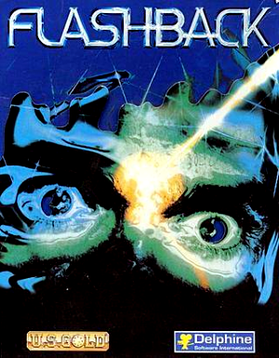
Flashback, released as Flashback: The Quest for Identity in the United States, is a 1992 science fiction cinematic platform game developed by Delphine Software of France and published by U.S. Gold in the United States and Europe, and Sunsoft in Japan.

Zero Tolerance is a 1994 video game developed by Technopop and published by Accolade exclusively for the Mega Drive/Genesis. It was one of the very few first-person shooters for the console, along with Bloodshot and Duke Nukem 3D.
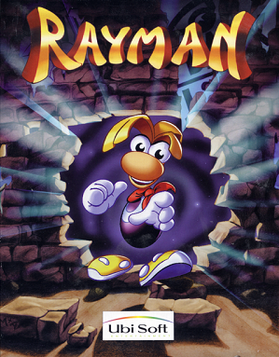
Rayman is a side-scrolling platform video game developed and published by Ubi Soft as the first installment of the Rayman series. It was originally released in September 1995 for MS-DOS, Windows, Atari Jaguar, Sega Saturn, and Sony PlayStation. The player controls Rayman, a hero who must restore balance to his colourful world from the evil Mr. Dark.
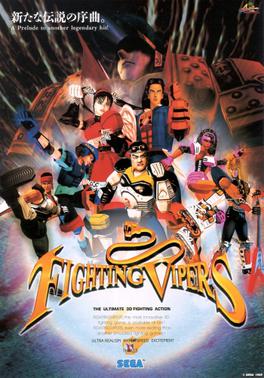
Fighting Vipers is a 3D fighting video game developed by Sega AM2. It uses the same game engine as AM2's Virtua Fighter 2 but features enclosed arenas and an armor mechanic, and was targeted more towards Western audiences, using a U.S. setting and more freeform styles of martial arts. The game was released in the arcade in 1995 using the Sega Model 2 hardware. The game was ported to the Sega Saturn, and to PlayStation Network and Xbox Live Arcade in 2012. Though Fighting Vipers was not very popular in North American arcades, the Saturn version was one of the most high-profile games in the system's 1996 holiday lineup, and was met with positive reviews.
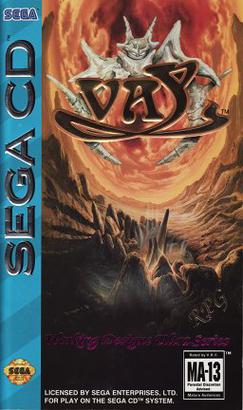
Vay, released in Japan as Vay: Ryuusei no Yoroi, is a 1993 role-playing video game for the Sega CD. It was developed by Hertz, published by SIMS in Japan, and localized by Working Designs for the United States. In 2008 it was re-released for the iPhone by SoMoGa, Inc.

Star Trek: The Next Generation is a 1994 adventure game developed and published by Spectrum HoloByte. The game features strategy and puzzle-solving elements. The game was released for the Super Nintendo Entertainment System, the Sega Genesis and the Sega Game Gear. It takes place in the Star Trek universe, spanning Federation space and the Romulan Neutral Zone, and centers on the appearance of the IFD, an artifact machine of unknown origin that, as its name suggests, allows its user to reshape matter and energy. It culminates in the IFD Trials, three tests undertaken by representatives of any races that are present when the Trials are held, and failure would mean the destruction of the Federation and the enslavement of countless worlds by the Federation's enemies.

Iron Man / X-O Manowar in Heavy Metal is a video game published by Acclaim Entertainment and developed by Realtime Associates for the PlayStation, Sega Saturn, Game Boy, Game Gear, and MS-DOS in 1996. It is a one or two-player side-scrolling action game in which the player battles villains from Marvel Comics' Iron Man and Valiant Comics' X-O Manowar comic book series. It was met with negative reviews which criticized it for dull gameplay and outdated graphics.

Robotica, also known as Robotica Cybernation Revolt in Europe and Deadalus (ダイダロス) in Japan, is a first-person shooter which was released for the Sega Saturn in 1995.

Loaded is a science fiction-themed top-down multidirectional shooter developed by Gremlin Interactive and published by Interplay Productions. Loaded was released on December 15, 1995 on the PlayStation, and was ported to the Sega Saturn the following year. The game had origins in DC Comics as well as the more adult-orientated Vertigo Comics, and there was a small graphic novel based on the game. The six playable characters of the game are a combination of villains, anti-heroes, psychopaths, perverts, mutants, and flamboyant murderers. They are, however, the best hope to stop the intergalactic supervillain nicknamed F.U.B. and save the universe. The characters were created and designed with contributions from Garth Ennis of Vertigo Comics and Greg Staples of 2000AD.
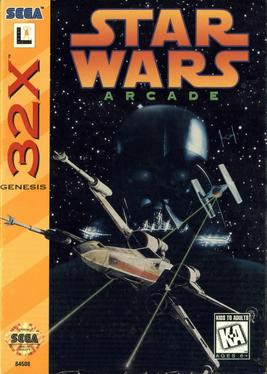
Star Wars is a 1993 arcade game developed by Sega and based on the original Star Wars trilogy. Combining elements of A New Hope and Return of the Jedi, the game has players pilot a Rebel starship and battle against the forces of the Empire. Sega developed Star Wars for their Model 1 system, the same arcade hardware that powered Virtua Fighter and Virtua Racing. Like those two titles, the graphics in Star Wars are rendered entirely using polygons. The game was given a home port under the name Star Wars Arcade, as an exclusive for the Sega 32X's launch in 1994.
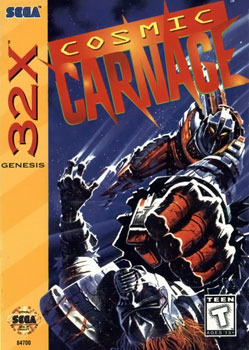
Cosmic Carnage is a 1994 fighting video game developed by Almanic Corporation, in conjunction with ALU, and published by Sega exclusively for the 32X add-on. Set in an uncharted star system, the game follows eight fighters from two factions in a struggle for survival. Its gameplay consists of one-on-one fights, with a main six-button configuration, featuring special moves and finisher techniques, as well as two playable modes. The title garnered mostly negative reception from critics since its release.

Star Fighter or Star Fighter 3000 is a 3D flight-based shoot-em-up developed and published by UK company Fendet Software, and released in 1994 for the Acorn Archimedes. The gameplay is mission based and involves elements of strategy and planning. The player can order wingmen to fly in formation and attack specific targets.

Android Assault: The Revenge of Bari-Arm, released in Japan as Bari-Arm (バリ・アーム), is a 1993 shoot 'em up video game developed and published by Human Entertainment for the Sega CD.

Total Eclipse is a space flight simulation video game developed and published by Crystal Dynamics for 3DO. It was later ported to the PlayStation under the title Total Eclipse Turbo. The game was copyrighted in 1993 and released 1994. Total Eclipse Turbo was a launch title for the PlayStation in the U.S., with the game's released date predating the North American console launch by 11 days. A sequel, Solar Eclipse, was released for Sega Saturn and PlayStation.

Shockwave Assault is a science fiction combat flight simulation video game developed by Advanced Technology Group and published by Electronic Arts for various home video game consoles and PCs. The player takes control of a futuristic fighter plane to defeat extraterrestrial ships and tripods.

Bruce Straley is an American game director, artist, designer, and studio director. He previously worked for the video game developer Naughty Dog, known for his work in the video games The Last of Us and Uncharted 4: A Thief's End. Straley's first video game work was as an artist at Western Technologies Inc, where he worked on the Menacer six-game cartridge (1992) and X-Men (1993). Following this, he formed a company, Pacific Softscape, where he worked as a designer on Generations Lost (1994). After the company disbanded, Straley was eventually hired at Crystal Dynamics, where he worked as a designer on Gex: Enter the Gecko (1998) and was initially game director for Gex 3: Deep Cover Gecko (1999); he left the company partway through development of the latter.



















